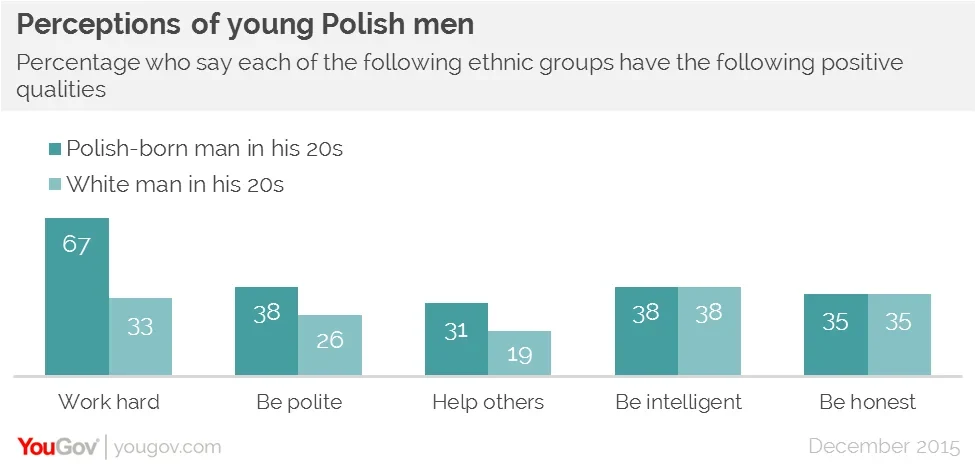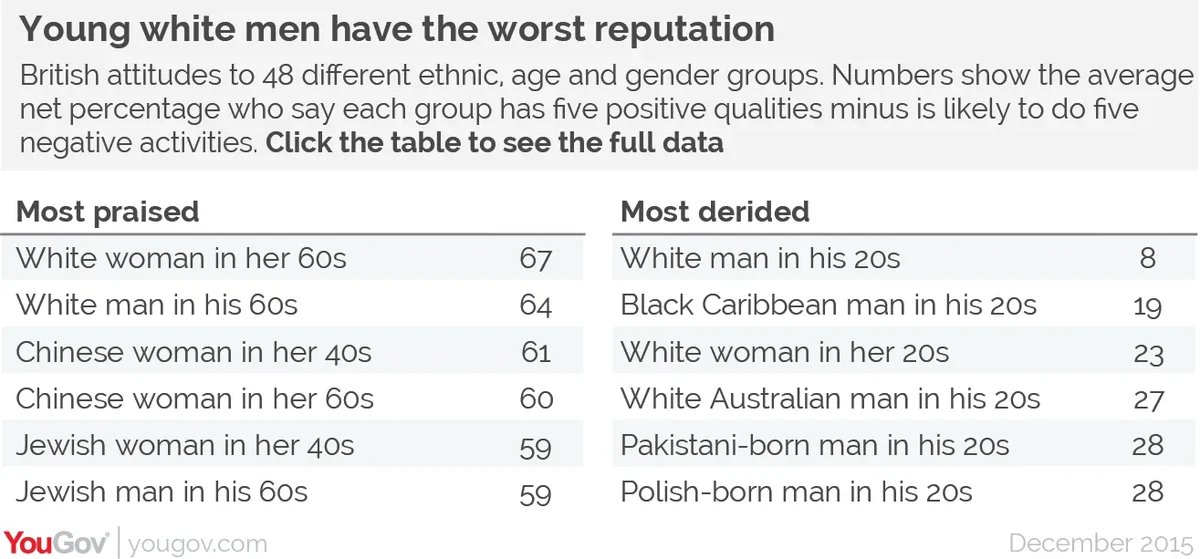YouGov data from 48 separate surveys reveals that young white men are seen as the worst ethnic, gender or age group on five negative traits – and the second worst on five positive traits
Whether our views flow from prejudice, the way Britain has changed in recent years or bitter personal experience, many of us judge people by their demographic group. When we encounter a stranger, our initial view will often depend on their age, gender and ethnic group. This is clear from YouGov’s latest surveys for Prospect. It is also clear that these judgements are seldom racist in the traditional sense. The people we regard as the laziest, rudest, most promiscuous, drunken drug-takers are white men in their twenties.
We explored attitudes to 48 different groups. We looked at each combination of eight ethnic/national groups, three ages (twenties, forties and sixties) and the two genders. For each group we asked respondents how likely they were to possess each of five positive qualities, such as intelligence and honesty, and five negative qualities, such as violence and drunkenness.
With such exercises, there is a danger that if people are asked to compare groups, some will veer towards giving the politically correct answer and score different groups the same. To avoid this, we conducted 48 separate surveys – one for each group. The interactive table found here shows the full findings. The figures in the left column show the net scores: the percentage giving positive responses minus the percentage giving negative responses. The absolute numbers tell us that most of us regard most groups on most attributes positively rather than negatively. But the extent to which that is so varies hugely.
Those variations are not just big but complex. Gender matters more than age or ethnicity. Look at the overall positive scores in the interactive table, where we combine responses to the five virtues. Five of the top six are women; five of the bottom six are men. Age and ethnicity also elicit different reactions, but normally within a narrower range. Three of the top six are Chinese, Jewish and black Caribbean – while white men in their twenties only just avoid last place. This is held by Pakistani-born men in their twenties. In particular, they are seen – fairly or unfairly – as less likely than any other group to be honest or to help others.
The lousy reputation of young white men is one of the most striking things to emerge from our surveys. When we look at individual characteristics, white men in their 20s have the worst reputation, out of all 48 groups, for drunkenness, sleeping around, hard work and politeness. They also have the joint worst score, with young black Caribbean men, for a belief that they are prone to drug-taking.
This is more than a curious poll finding. Immigration from eastern Europe is one of the most fraught political issues these days, and at the root of David Cameron’s attempts to renegotiate Britain’s relationship with the European Union. Are young Polish men, in particular, taking jobs from young white Britons? If they are, our results suggests that it is in large measure because we hold young Polish men in much higher regard.
Our graphic compares the reputations of young white and Polish men on each of the five virtues we tested. We see no difference in their intelligence and honesty. But on the other three, Poles clearly do better. We think they are more likely to be polite and to help others – and far more likely to work hard.

As with all our other findings, we should stress that these are perceptions. Whether they reflect the objective truth is a matter for debate. Maybe it’s a myth that young Poles coming to Britain work harder than white Britons who are born here. But if it is a myth, it is one that seems to have put down deep roots. If, as seems likely, it is one that is believed not just be the general public by employers – from company executives to householders looking for a plumber – then the lesson is clear. Changing the welfare rules is unlikely to stem the phenomenon of Polish men “taking” jobs from white Britons. The reputation of young white men must improve substantially. This chimes with the point that David Blunkett, among others, has long made: that too many white children fail at school and become adults ill-equipped to become good workers, husbands and fathers. Stopping new immigrants from receiving in-work benefits is tackling the wrong problem.
Most of the characteristics we tested have a cultural component. Perceived differences may reflect our sense that different communities have different attitudes – for example, to alcohol. It is surely no surprise that Pakistani women in their 60s are the group we say are least likely to get drunk frequently.
However, there is one characteristic that I consider to be independent of ethnicity: intelligence. If there is something close to a “pure” measure of racist sentiment, or lack of it, it is here. In overall terms, the difference between beliefs about the “best” and “worst” ethnic groups is narrower for intelligence than for most other characteristics. Jewish and Chinese men and women come out slightly ahead of other groups, while Muslim, Pakistani and Polish folk lag behind – but the gap is modest. This finding holds good, whatever the age, gender or social class of the respondent.
However, one group of respondents thinks differently. People who voted Ukip in May tend to be far more critical of Polish, Pakistani, Muslim and black Caribbean people than Jewish, Chinese, white or Australian people, on virtually every characteristic – including intelligence. Ukip regard Chinese as the most intelligent of our eight ethnic groups (average net score, plus 58), and Muslims as the least intelligent (net score plus 12). That 46-point chasm between the highest and lowest-rated ethnic groups compares with much smaller differences among those who voted Conservative (27), Labour (15) or Liberal Democrat (16).
Many Ukip voters would doubtless argue that their views are more honest and realistic than those held by the rest of us. More broadly, we can debate whether what need to change are the different cultural norms of different groups, or public perceptions, or both. However, we should not be too pessimistic. Had similar research been conducted fifty years ago, the gulf between the most and least admired groups might well have been far wider. But it is still too wide for comfort. Perhaps the starting point for narrowing it further is an honest debate about the extent to which we need to change perceptions – and the extent to which we need to change reality.
See the full interactive data table
This article first appeared in Prospect
PA image









